Getting into a new genre or format is always intimidating. Manga is a Japanese form of comics that tends to be endlessly marathonable: once you get started on a series, you want to sit down and read them all. For me, the most exciting thing about starting to read manga was that it already had a sub-genre dedicated to F/F romance…kind of. Yuri is a tricky thing to define, but it’s generally used to describe manga or anime that includes F/F romance or lesbian subtext. The problem is that this is a huge spectrum: you may pick up a book expecting lesbian manga, and instead get some Significant Glances or blushing and that’s about the extent of the LGBTQ content.
I am still a newcomer to reading yuri and lesbian manga, so I defer to Erica Friedman’s definition of yuri vs. lesbian manga. Friedman runs a yuri site called Okazu, which started in the early 2000s. Not only has she been writing about and reviewing yuri for almost two decades, but she also regularly gives presentations about the history of yuri. If you want an overview of the term, here is a video that goes over the basics.
For the purposes of this post, I’ll use Friedman’s definition: “Yuri is lesbian content without lesbian identity.” This makes it necessarily a subjective label. Some people may consider a manga yuri, and others won’t count it. On Okazu, manga that explicitly discusses identity labels is not categorized as yuri, and instead is filed as LGBTQ manga. In that same vein, I’m going to start off with recommendations of lesbian manga: these titles generally use the word “lesbian” or more broadly discuss being queer as an identity. These are still fairly rare, however, so I’ll also give some recommendations for yuri manga that have canonical F/F romances, even if they don’t use identity labels.
Lesbian Manga
My Lesbian Experience With Loneliness by Nagata Kabi
This is the obvious place to start this list, but it’s also an exception: this is the only nonfiction manga included. My Lesbian Experience with Loneliness details the author’s struggles with mental health, coming out, and—of course—loneliness. It is vulnerable and raw to the point that it is sometimes uncomfortable to read, but it offers an honesty that hadn’t been present in yuri/lesbian manga before this. It was also a huge hit, and its popularity not only ensured the publication of sequels (My Solo Exchange Diary, My Solo Exchange Diary, Vol. 2, and the upcoming My Alcoholic Escape from Reality), but also opened the door for more lesbian manga that looks frankly at lesbian identity and coming out in Japan.
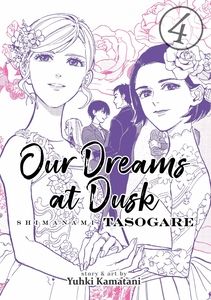
Our Dreams at Dusk by Yuhki Kamatani
Admittedly, this series follows a gay teenager who is coming to terms with his identity, but it is one of the most queer manga series out there. It follows Tasuku, who is considering suicide because of the bullying he’s faced at school for being perceived as gay. He is distracted by seeing a woman jump from a high ledge, and follows her to a drop-in center. It is run by this mysterious woman, and soon she has him volunteering to help out. He is stunned when he meets Haruko, who casually mentions her wife. The final volume in the series follows the planning of a wedding ceremony between two women, who are Tasuku’s inspiration to come out.

I Married My Best Friend To Shut My Parents Up by Kodama Naoko
I know: the title doesn’t exactly scream quality representation. This short, standalone manga is surprisingly thoughtful, though. It’s about a fake marriage: Morimoto is sick of being constantly set up by her parents. Her friend Hana suggests that they get married (or, at least, get an equivalent partnership certificate offered in some regions). Morimoto finds herself agreeing to this plan, despite her parents’ outrage and despite her knowledge that Hana is an out lesbian and had feelings for her in high school. Unsurprisingly, once they start living together, their relationship begins to change. Not only does this have a character who identifies as a lesbian, it also deals with having abusive and controlling parents, and even some discussion of consent. Do be prepared for a very short manga, though: the last section of the book is a short story.
Yuri Manga: the Classics
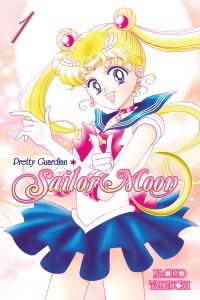
Pretty Guardian Sailor Moon by Naoko Takeuchi
Before there was lesbian manga, there were the classics of yuri manga. The one that’s probably most well-known is Sailor Moon. Although Usagi is arguably bisexual, that’s a whole other tangent. What made Sailor Moon so significant to the yuri genre was the relationship between Haruka (Sailor Uranus) and Michiru (Sailor Neptune). Their long-standing relationship is included without fanfare, which was fairly unusual at the time, especially for a series that achieved such popularity around the world. While the American TV adaptation tried to rewrite the two as cousins, there’s no way to mistake their relationship in the original books.
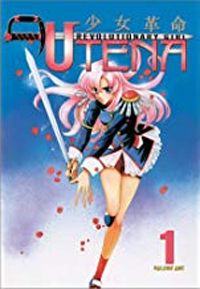
Revolutionary Girl Utena by Chiho Saito
Revolutionary Girl Utena owes a lot to the Magical Girl manga genre, but it is its own surreal masterpiece. It follows Utena who, as a young child, was saved by a prince. She’s so impressed that she vows to grow up to become a prince herself. Now, she’s at a private school (where all the girls swoon over her), and she stumbles on a dueling club. This club duels for the Power to Revolutionize the World and the Rose Bride. The Rose Bride is a fellow student, Anthy, who seems to be acting as a prop in their game. Utena joins the duel to protect Anthy, and finds herself drawn into a dreamlike world where castles descend from the sky and you settle every interpersonal conflict with fencing skills. In the original manga, the relationship between Anthy and Utena is heavily subtextual. It’s been adapted to many formats, though (anime, movie, standalone manga, manga short stories), and is often canonical in those.
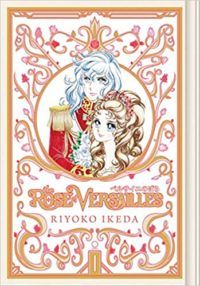
The Rose of Versailles by Riyoko Ikeda
Predating any of these was The Rose of Versailles, which was serialized in 1973 and published in 10 volumes in 1982. It follows Oscar François de Jarjeyes, a young noblewoman raised as a son who is now the commander of Marie Antoinette’s guard. There is yuri content: Oscar and another female character, Rosalie, acknowledge that they have feelings for each other, and if Oscar was a man, they’d be together. Beyond that, though, the playing with gender in this series has likely affected yuri manga more than any actual F/F content. It’s not hard to see how Utena may have been influenced by this earlier work.
Where to Start With Yuri Manga
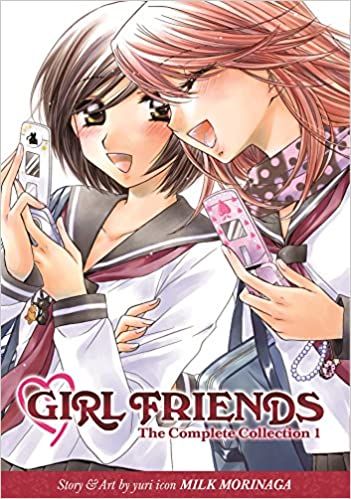
Girl Friends by Milk Morinaga
While lesbian manga is still pretty rare, there is a lot more yuri manga being published that is inarguably F/F (not just subtext). One of the foundational series in this vein is Girl Friends. This follows most of the common tropes in yuri: it follows two schoolgirls, one of whom has a crush on the other. There is a lot of blushing and the typical “girls don’t do this” heteronormativity. The first omnibus is about 500 pages, and it’s a slow burn: the majority of this first collection is just about them becoming friends. I thought the second volume was stronger, because SPOILER: it deals more with their relationship than just the pining, and it takes them seriously as a couple, even after graduation.

Bloom Into You by Nakatani Nio
This series has become hugely popular. It follows Yuu, who is a big fan of shoujo manga and is waiting for her whirlwind romance. When she does get a confession of love from a boy, however, she finds herself uninterested and turning him down. Later, she sees Nanako—who is running for school president—also turn down a suitor, and strikes up a conversation, thinking they have something in common. She’s taken aback when soon Nanako is also declaring her love for Yuu. Yuu doesn’t return her feelings, but agrees to be “wooed.” Unsurprisingly, based on the premise, it can veer into questionable consent territory: Nanako is sometimes pushy. They do discuss this when it happens, though, and over the course of the series, this becomes an engaging and cute romance that keeps you flipping pages.
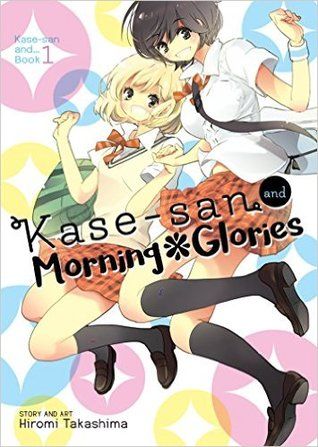
Kase-san and Morning Glories by Hiromi Takashima
This is told in a series of vignettes as Yamada meets Kase, a tomboy track star. They bond over their shared love of the gardens at their school, and their romance slowly begins to blossom. (I’m sorry. I couldn’t help it.) There is the typical “but we’re both girls!” angst and includes some fan service, but overall, it’s a cute and fluffy F/F romance. In the second volume, SPOILER: they try to navigate being a couple and exploring the sexual aspect of their relationship.
Although this is a high school romance, there is a sequel series called Kase-san and Yamada that takes place in college!
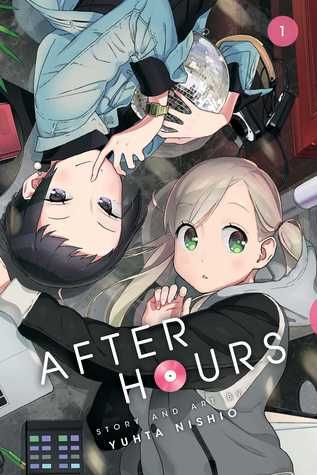
After Hours by Yuhta Nishio
This is one of the few books on this list that follows adult characters! Emi is ditched by her friend in a dance club, and she’s overwhelmed by the loudness and crush of people. When she starts getting hit on, she starts looking for an exit and is rescued by Kei, a DJ. They go home together, and Emi finds herself drawn into Kei’s exciting, artistic life. This is one of the few yuri mangas to include a sex scene that doesn’t seem to be for fan service, and both women already seem comfortable with their sexuality—in fact, Emi is likely bisexual, which is another rarity on this list.

Sweet Blue Flowers by Takako Shimura
When Akira starts at a new high school, she isn’t expecting to run into her best friend from kindergarten, Fumi! They strike up their friendship again, but Fumi is trying to mend a broken heart: her girlfriend left her and is getting married. She’s glad to be asked out by another classmate, Sugimoto, but she’s struggling to get over her last relationship. Akira is protective of Fumi and tries to help her move on. This is the same mangaka who wrote Wandering Son, which is a beloved manga series featuring trans characters. (In fact, this one discusses identity enough that it might even belong in the lesbian manga category.)

Citrus by Saburo Uta
I am conflicted about this title, because on the one hand, it’s the most absorbing manga series I’ve ever read. On the other hand…just look at that cover. It follows Yuzu, a fun-loving girl who’s just started at a new high school and is shocked by their strict rules. She immediately comes into conflict with Mei, the student council president, who has no tolerance for her. Then, plot twist, Mei turns out to be Yuzu’s new stepsister! This is a romance between stepsisters, but they have just met. There is questionable consent, but it is grappled with: Mei has gone through sexual abuse, and has a fractured relationship with her sexuality. This isn’t an entirely healthy relationship, and there’s definitely a lot of angst, but it is captivating.
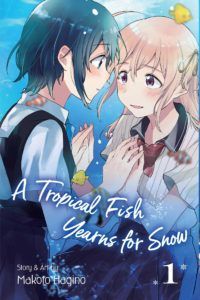
A Tropical Fish Yearns for Snow by Makoto Hagino
This is a typical blushing schoolgirl yuri romance, with a lingering hug acting as the climax of the story, but I really enjoyed it. Konatsu is just starting at a new school (is anyone else noticing a pattern?), and they are holding an event hosted by the Aquarium Club. When she attends, she runs into the sole member of the club, Koyuki, and they share a shy conversation. Konatsu discovers that she has to join a school club—will she choose the Home Ec Club that her friendly classmate Kaede invited her to, or will she help out Koyuki at the Aquarium Club? This is an adorable story, and I liked that Konatsu helps Koyuki to take some time for herself and not always live up to the standard others hold her to. I also thought the aquarium theme made for beautiful illustrations.

Miss Kobayashi’s Dragon Maid by coolkyousinnjya
Kobayashi has a pretty regular life working as a programmer—until she bumps into Tohru. Tohru is a dragon, and she seems to hate every human except Kobayashi, which means they end up living together. It turns into a slapstick slice-of-life comedy with a lot of crass humor. Despite all the ridiculousness, this is still one of the few yuri manga series with adult main characters.
This is far from a complete list! There is a lot more yuri manga out there and more is getting published all the time. Unfortunately, lesbian manga is still pretty hard to come by. If you have recommendations of lesbian manga (manga that discusses lesbian identity) that didn’t make it to this list, let me know on Twitter!
Looking for more sapphic comics? Check out:
- 9 of the Best Comics With F/F Relationships
- 35 Fantastic Lesbian Comic Books And Graphic Memoirs
Looking for more manga? Check out:
- 50 Best Manga You Must Read Right Now
- The Book Riot manga section!
Source : Lesbian Manga and Yuri Manga: What’s the Difference and Where Should You Start?











